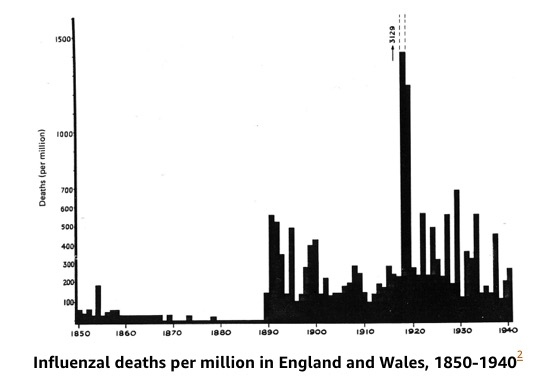WHEN DID INFLUENZA BECOME ANNUAL?
- Mark Playne
- Jun 20, 2023
- 2 min read
An excerpt from The Invisible Rainbow
In 1889, most historians agree, the modern electrical era opened. And in 1889, as if the heavens had suddenly opened as well, doctors in the Americas, Europe, Asia, Africa, and Australia were overwhelmed by a flood of critically ill patients suffering from a strange disease that seemed to have come like a thunderbolt from nowhere, a disease that many of these doctors had never seen before.
That disease was influenza, and that pandemic lasted four continuous years and killed at least one million people. Influenza is an Electrical Disease.
Suddenly and inexplicably, influenza, whose descriptions had remained consistent for thousands of years, changed its character in 1889. Flu had last seized most of England in November 1847, over half a century earlier. The last flu epidemic in the United States had raged in the winter of 1874–1875.
Since ancient times, influenza had been known as a capricious, unpredictable disease, a wild animal that came from nowhere, terrorized whole populations at once without warning and without a schedule, and disappeared as suddenly and mysteriously as it had arrived, not to be seen again for years or decades. It behaved unlike any other illness, was thought not to be contagious, and received its name because its comings and goings were said to be governed by the “influence” of the stars.

But in 1889 influenza was tamed. From that year forward it would be present always, in every part of the world. It would vanish mysteriously as before, but it could be counted on to return, at more or less the same time, the following year. And it has never been absent since.

Like “anxiety disorder,” influenza is so common and so seemingly familiar that a thorough review of its history is necessary to unmask this stranger and convey the enormity of the public health disaster that occurred one hundred and thirty years ago. It’s not that we don’t know enough about the influenza virus.
We know more than enough.
The microscopic virus associated with this disease has been so exhaustively studied that scientists know more about its tiny life cycle than about any other single microorganism. But this has been a reason to ignore many unusual facts about this disease, including the fact that it is not contagious.
In 2001, Canadian astronomer Ken Tapping, together with two British Columbia physicians, were the latest scientists to confirm, yet again, that for at least the last three centuries influenza pandemics have been most likely to occur during peaks of solar magnetic activity—that is, at the height of each eleven-year sun cycle.
Pages 80–81 of The Invisible Rainbow: A History of Electricity and Life
1889 - what happened in that year?

This 'gold rush' of connecting housing by cables happened as each company competed with the next to get each building on an electricity meter..



The EMF's caused by the currents running through these wires were immense...
If the EMFs from solar flares caused influenza, did the EMFs caused by these cables cause Influenza?
And if EMFs cause influenza, what caused Covid 19?
A virus?
Or... electromagnetic frequencies?
Read more free excerpts and summaries in several languages





























What was being connected to houses in 1889? Was is electrical power or telephonic devices? The pictures show telegraph wires but the text refers to electricity meters. These two have completely different frequencies, voltages and other characteristics. We need to be clear about what is being referd to here and the mismatch between the photos and the descriptions is unhelpful.
The evidence is compelling.
The evidence is truly compelling.